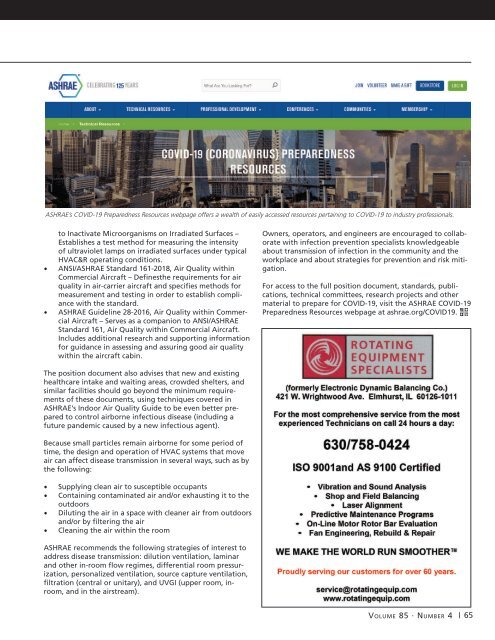CEAC-2020-04-April
Create successful ePaper yourself
Turn your PDF publications into a flip-book with our unique Google optimized e-Paper software.
ASHRAE’s COVID-19 Preparedness Resources webpage offers a wealth of easily accessed resources pertaining to COVID-19 to industry professionals.<br />
to Inactivate Microorganisms on Irradiated Surfaces –<br />
Establishes a test method for measuring the intensity<br />
of ultraviolet lamps on irradiated surfaces under typical<br />
HVAC&R operating conditions.<br />
• ANSI/ASHRAE Standard 161-2018, Air Quality within<br />
Commercial Aircraft – Definesthe requirements for air<br />
quality in air-carrier aircraft and specifies methods for<br />
measurement and testing in order to establish compliance<br />
with the standard.<br />
• ASHRAE Guideline 28-2016, Air Quality within Commercial<br />
Aircraft – Serves as a companion to ANSI/ASHRAE<br />
Standard 161, Air Quality within Commercial Aircraft.<br />
Includes additional research and supporting information<br />
for guidance in assessing and assuring good air quality<br />
within the aircraft cabin.<br />
Owners, operators, and engineers are encouraged to collaborate<br />
with infection prevention specialists knowledgeable<br />
about transmission of infection in the community and the<br />
workplace and about strategies for prevention and risk mitigation.<br />
For access to the full position document, standards, publications,<br />
technical committees, research projects and other<br />
material to prepare for COVID-19, visit the ASHRAE COVID-19<br />
Preparedness Resources webpage at ashrae.org/COVID19.<br />
The position document also advises that new and existing<br />
healthcare intake and waiting areas, crowded shelters, and<br />
similar facilities should go beyond the minimum requirements<br />
of these documents, using techniques covered in<br />
ASHRAE’s Indoor Air Quality Guide to be even better prepared<br />
to control airborne infectious disease (including a<br />
future pandemic caused by a new infectious agent).<br />
Because small particles remain airborne for some period of<br />
time, the design and operation of HVAC systems that move<br />
air can affect disease transmission in several ways, such as by<br />
the following:<br />
• Supplying clean air to susceptible occupants<br />
• Containing contaminated air and/or exhausting it to the<br />
outdoors<br />
• Diluting the air in a space with cleaner air from outdoors<br />
and/or by filtering the air<br />
• Cleaning the air within the room<br />
ASHRAE recommends the following strategies of interest to<br />
address disease transmission: dilution ventilation, laminar<br />
and other in-room flow regimes, differential room pressurization,<br />
personalized ventilation, source capture ventilation,<br />
filtration (central or unitary), and UVGI (upper room, inroom,<br />
and in the airstream).<br />
Volume 85 · Number 4 | 65


















